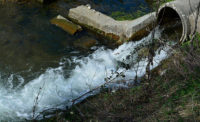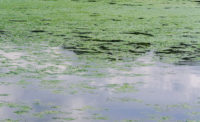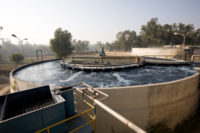The latest wastewater treatment technology doesn’t always apply to smaller plants. How are poultry and beef facilities adjusting old formats to new treatment choices?
In LaGrange, Ind., Gunthorp Farms combines old and new technology. The processor has its own slaughter operations and produces smoked meats and value-added products to sell to upscale restaurants and retail locations in Chicago, Indianapolis and Detroit.
Around since the Great Depression, the farmer strives to use few chemicals but create sanitary conditions by utilizing facility sanitation, conscientious hand evisceration, slow line speeds and copious amounts of water and rapid chilling, thereby avoiding chlorine for antimicrobials.
“We have a constructed wetland for our wastewater treatment,” says Greg Gunthorp, fourth-generation hog farmer of Gunthorp Farms. “Our water that we use goes back in the ground cleaner than 70 percent of the world’s drinking water.”
The Environmental Protection Agency (EPA) defines constructed wetlands treatment systems as “engineered systems that have been designed and constructed to utilize the natural processes involving wetland vegetation, soils and their associated microbial assemblages to assist in treating wastewater.” Some are created to treat wastewater while others are designed to create and restore wetland habitats for wildlife and environmental improvements.
Working with smaller footprints
Smaller footprints can prevent facilities from building a wetland treatment system. More often, facilities still use anaerobic ponds with activated sludge systems, which use bacteria to treat wastewater.
“It’s more common to have activated sludge systems, although we are starting to see some membrane bioreactors [MBR],” says Bruce Dvorak, Ph.D., civil engineering professor at the University of Nebraska-Lincoln who works with beef and pork facilities. “Why? Legacy.”
Many facilities were built 50 to 60 years ago, and have long used anaerobic ponds to treat waste. Generally, wastewater is treated in multiple steps: dissolved air flotation (DAF) to remove about 80 percent of the organic load and 65 percent of the nitrogen load, anaerobic digestion to break down remaining sludge and create biogas for energy, and converting the leftover sludge into fertilizer.
“It’s not often we get to start from scratch and advise a company — a ‘green-field plant’ — not limited by history,” says Dvorak.
As companies grow, they don’t have enough land for new treatment systems. “We need to make technology more accessible for smaller spaces,” he says.
A few poultry processors are using MBR, a relatively new technology that uses a smaller footprint to treat water because it doesn’t utilize settling and clarification to remove solids. Instead, membranes act as filters to remove large loads of suspended solids and other substances from wastewater. Its cost is relatively high compared to current treatments, however, although it is decreasing.
“There are very big opportunities for tech suppliers to help facilities find better ways to collect water and waste, produce biogas [methane] or burn pork grease [to replace gas as fuel],” Dvorak says.
By the rules
Besides space constraints, wastewater treatment is determined by the local permits and standards where the poultry or meat company is located, says Paul Bredwell, vice president of environmental programs at USPOULTRY, based in Tucker, Ga.
“If a plant has a National Pollutant Discharge Elimination System (NPDES) permit — through the Clean Water Act — it can’t discharge waste to water like lakes or streams until it has undergone a biological treatment like an activated sludge system, in which bacteria eats the pollutants,” he says.
The treated water is then sent to a clarifier to re-capture bacteria through an aeration system. Usually, the resulting product, the effluent, is screened for limited equalization before flowing to a DAF unit, aerated lagoon, sequencing batch reactor (SBR) and more lagoons.
“The system filters and disinfects the water multiple times before it’s discharged to the environment,” says Bredwell.
If a plant has an indirect discharge permit, it sends its pretreated water to a publicly owned treatment works (POTW), which cleans the water again before discharging it into the nearby waterbody.
First, the food plant treats its wastewater by using a DAF tank with chemicals to remove a certain level of the total distended solids. “Then it’s typically discharged to a municipal plant to be treated with an activated sludge system,” says Bredwell. “So, the water is taken from a high amount of pollutants down to something that could come from a home or store.”
Decreasing nutrient pollution
Going forward, nutrient pollution remains a constant challenge. “The EPA is trying to decrease nutrients in wastewater because they can cause algae blooms that kill the fish in nearby water,” Bredwell says.
So, permits focus on keeping nitrogen and phosphorus to low levels in wastewater, such as the 0.1 mg/L to 0.5 mg/L range. “The only way to achieve that is through nutrient removal,” says Bredwell.
The EPA and regulatory agencies are also concerned about pharmacy and personal care products in local municipalities that don’t have the resources to remove all drugs in water systems, notes Bredwell.
“The notion that poultry processing plants are big polluters isn’t true,” says Bredwell. “All of these plants operate under permits; they keep and report records and are diligent about the level of treatment that goes into their facilities. These are certified, licensed professionals who take their jobs seriously.” NP
Recycling H2O
Water isn’t as cheap as it used to be. While West Coast facilities may have taken the lead on conserving and reusing water from meat and poultry facilities out of necessity, other regional plants have to consider their roles as environmental stewards.
“We help plants decrease their water use,” says Bruce Dvorak, Ph.D., civil engineering professor, University of Nebraska-Lincoln. “A simple area to start is understanding how much water is used during overnight cleaning. Also, putting alternative nozzles on hoses can decrease water use by a third.”
Another water-saving measure is turning off the bird wash (through electric eyes) if the line is shut down, says Paul Bredwell, vice president — environmental programs, USPOULTRY, based in Tucker, Ga.
Facilities are focused on reusing water where they can, but they have to follow FDA’s standards on contact water vs. non-contact water. “Non-contact water can be used to flush feathers down the drain or wash down trailers,” Bredwell says.
To reuse water, plants have to make big and small changes, such as changing their plumbing by installing new water lines underneath their equipment, which is costly, notes Dvorak.
“They also have to change their perception that water is ‘cheap,’” says Dvorak. “We can save money by finding more uses for cold water, so biofuels don’t have to be wasted heating it.”
Another area to keep an eye on is pH controls in water. “Some cleaning solutions have a lot of alkaline,” Dvorak says. “It helps facilities to understand what drives pH upsets — an acid base needs to be added.”
Reverse osmosis (RO), a water purification process, filters water through partially porous membranes, which continue to be refined.
“While some companies are starting to look at it to recycle into plants as contact water, the FDA has not given contact water standards,” Bredwell says. “One to two plants have played with RO, but they are hamstrung if they don’t get FDA permission.”







